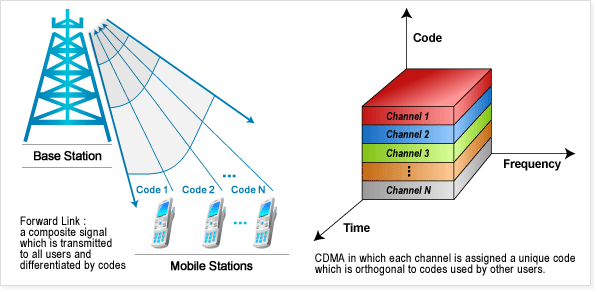When you evaluate your options for satellite phones, you may hear terms such as “geosynchronous orbit” or “low Earth orbit,” referring to the type of satellite the provider uses. While each offers advantages, the type of satellite used does not tell the whole story when it comes to evaluating the signal quality on your satellite phone.
Calls made on satellite phone networks do not “beam” directly from the phone to the satellite and back. When you make a call, the signal travels to a ground-based switching station, which in turn sends the signal to the nearest satellite. This allows for satellite calls to be made to and from land lines or cellular phones. However, not all signals are created equally; some signal types are better than others when it comes to call quality.
That’s where CDMA comes in. Code division multiple access, or CDMA, is the foundation of third-generation cellular service around the globe and the most common type of signal used in cellular phones. However, it’s only used by one satellite phone provider — Globalstar — and provides a number of significant advantages.
The Basics of CDMA
CDMA is the code language that turns your voice into a digital signal to be transmitted wirelessly. Whenever you make a call on a cellular or Globalstar network, your words and data are converted into a unique code. This code differentiates your call from the thousands of others taking place over the network at the same time. Without these codes, all conversations would meld into one, unidentifiable mass of noise.
The CDMA most commonly used in cellular phones was introduced by Qualcomm in the mid-1990s, and is mostly used in North America and Asia. The rest of the world relies primarily on GSM, or global system for multiple access. A few American cellular carriers use GSM, which generally offers faster data transmission speeds. Those faster speeds are useful to people using their phones for surfing the Web, emailing or checking social media. On cellular networks, GSM allows more flexibility in terms of using phones across carriers and better coverage in rural areas.
When it comes to satellite phones, though, it’s a different story.
CDMA and Satellite Phones
When the Globalstar network launched in 2000, the company chose to use CDMA technology because it was the most advanced signal technology of the timeand offered multiple advantages over existing satellite service providers.
More than a decade later, the choice to use CDMA gives Globalstar some distinct advantages. Technology advances have created top-notch signal quality, meaning calls made over the network are clearer than any other, particularly when one caller is using a cellular device. In fact, the quality of satellite calls made with CDMA phones is equal to, or even better than, calls made on cellular networks.
CDMA also reduces the delay and echo often found on satellite phone calls. When you make or receive a call from a satellite phone, there is often a delay of up to a second or longer. Advanced CDMA technology reduces or eliminates that delay, as well as the echo present on many satellite calls. We’ve all had conversations on our cellular phones in which everything said repeats one or more times; it’s common on some satellite phone, but essentially eliminated by CDMA.
CDMA also improves the security of calls made on satellite networks. Again, every call has its own unique code sequence, making it difficult for intruders to intercept and listen in to calls. It’s rare calls on this type of network “cross,” and you generally will not have to deal with static or interference from other conversations.
Finally, one of the major advantages of Globalstar’s use of CDMA technology is it allows some devices to be used on either cellular or satellite networks. In places where a cellular network is readily available, such as a major city, your device will connect via cellular service, saving you time and money. When you move into a more remote area, it will shift to satellite mode, allowing you to stay in touch — even if there isn’t a cell tower in hundreds of miles.
When you’re evaluating your satellite phone options, ask about the signal type. Depending on where you are going and how you plan to use your phone, a CDMA-equipped model may be your best bet.
About the Author: Steve Manley is the owner of Globalcom Satellite Communications. Visit www.GlobalcomSatPhone.com to learn more about your satellite phone options today.










